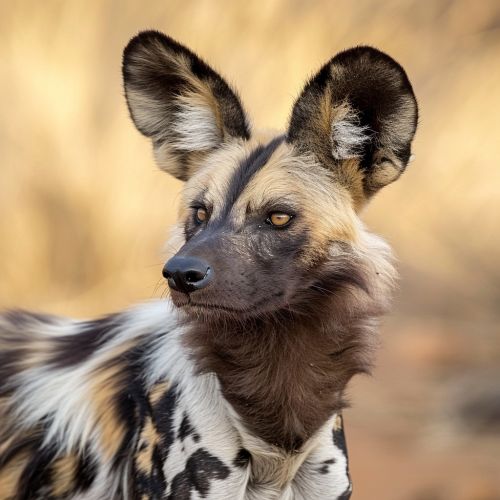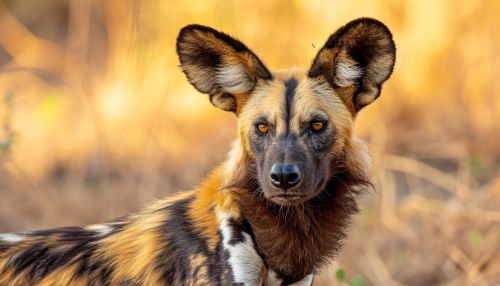African wild dog
Taxonomy and Evolution
The African wild dog (Lycaon pictus), also known as the African painted dog, or Cape hunting dog, is a canid native to Sub-Saharan Africa. It is the largest indigenous canid in Africa, and the only extant member of the genus Lycaon, which is distinguished from Canis by its fewer toes and dentition, which is highly specialized for a hypercarnivorous diet.


Description
African wild dogs are distinguished by their unique coat patterns, which are made up of patches of red, black, brown, white, and yellow fur. Each individual has its own unique coat pattern, and this pattern can be used to identify individuals. The dogs have large, rounded ears and dark brown circles around their eyes. The dogs are lean and muscular, with long legs and a thin body, which is adapted for speed, agility, and endurance.
Behavior
African wild dogs are highly social animals, living in packs with separate dominance hierarchies for males and females. Uniquely among social carnivores, the females rather than the males disperse from the natal pack once sexually mature. The young are allowed to feed first on carcasses. The species is a specialized diurnal hunter of antelopes, which it catches by chasing them to exhaustion. Like other canids, African wild dogs regurgitate food for their young, but also for adults, to the point of being observed regurgitating after a hunt when no young are present.
Reproduction
African wild dogs exhibit a monogamous breeding pair within each pack. The female has a litter of 2 to 20 pups, which are cared for by the entire pack. These dogs are very social, and packs have been known to share food and to assist weak or ill members. Social interactions are common, and the dogs communicate by touch, actions, and vocalizations.
Diet
African wild dogs have a diverse diet, but they primarily prey on medium-sized ungulates. They are opportunistic predators and also eat smaller animals, birds, and insects. They are known to hunt in packs and use strategic tactics to corner and capture their prey. They have a high hunting success rate, but also face competition from larger predators like lions and hyenas.
Distribution and Habitat
African wild dogs are found primarily in savanna and arid zones, generally avoiding forested areas. This species was once widespread across Africa, but populations have been drastically reduced and are now fragmented. Major threats to the African wild dog include habitat fragmentation, human-wildlife conflict, and diseases like rabies and distemper.
Conservation
African wild dogs are currently classified as Endangered by the IUCN. Conservation efforts for the African wild dog include protecting its natural habitat, reducing human-wildlife conflict, and monitoring disease outbreaks. These efforts are often carried out in collaboration with local communities, non-governmental organizations, and government agencies.
